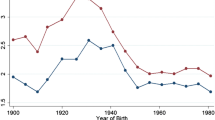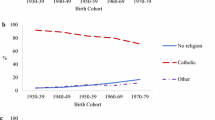Abstract
The effects of religion on the fertility patterns of Mexican Americans are examined with two different path models, the Institutional Model using formal affiliation with the Roman Catholic Church as a measure of religion, and the Religiosity Model using a measure of religiosity. Each model, tested separately for husbands and wives, examines the effects of religion on types of contraceptive methods used and on wanted family size. Although the majority of Mexican Americans are Catholics and tend to have large families, religion does not seem to have the same effect on their fertility patterns as on that of other Catholics in the United States. Among the men, neither formal affiliation nor religiosity affect the fertility patterns in any way, while among the women the effect is slight. Considering the Catholic Church’s position on contraceptive usage, it is especially noteworthy that religion does not affect the use or non-use of the more effective means of contraception, a factor contributing to the generally weak association between the measures of religion and wanted family size. The last section attempts a partial explanation of why the results turned out as they did.
Similar content being viewed by others
References
Bradshaw, Benjamin S., and Frank D. Bean. 1972. Some Aspects of Mexican-American Fertility. Report of the Commission on Population Growth and the American Future, Research Papers. In Press. Washington, D. C.: Government Printing Office.
Bumpass, Larry L., and Charles F. Westoff. 1970. The Later Years of Childbearing. Princeton, N. J.: Princeton University Press.
Freedman, Ronald, Pascal K. Whelpton, and Arthur A. Campbell. 1959. Family Planning, Sterility, and Population Growth. New York: McGraw-Hill.
Grebler, Leo, Joan W. Moore, and Ralph C. Guzman. 1970. The Mexican-American People, the Nation’s Second Largest Minority. New York: The Free Press.
Heise, David R. 1968. Problems in Path Analysis and Causal Inference. Pp. 38–77 in Edgar F. Borgatta (ed.), Sociological Methodology: 1969. San Francisco: Jessey-Bass, Inc.
Jones, Gavin, and Dorothy Nortman. 1968. Roman Catholic Fertility and Family Planning: A Comparative Review of the Research Literature. Studies in Family Planning 34:1–27.
Lee, Eun-Sul, Robert E. Roberts, and Ralph F. Frankowski. 1972. Fertility Patterns of Spanish-Surname Women in the Five Southwestern States. Unpublished paper presented at the annual meeting of the Population Association of America, Toronto, Canada.
Lopreato, Joseph. 1970. Italian Americans. New York: Random House.
Nostrand, Richard L. 1970. The Hispanic-American Borderland: Delimitation of an American Culture Region. Annals of the Association of American Geographers 60:638–661.
Nygreen, G. T. 1971. Interactive Path Analysis. The American Sociologist 6:37–43.
Potvin, Raymond H., Charles F. Westoff, and Norman B. Ryder. 1968. Factors Affecting Catholic Wives’ Conformity to Their Church Magisterium’s Position on Birth Control. Journal of Marriage and the Family 30:263–272.
Ryder, Norman B., and Charles F. Westoff. 1971. Reproduction in the United States 1965. Princeton, N. J.: Princeton University Press.
U. S. Bureau of the Census. 1971. Current Population Reports, Series P-20, No. 226 (November).
—. 1972. U. S. Census of Population and Housing: 1970. Census Tracts. Final Report PHC(1)–l7. Austin, Texas. SMSA. Washington, D. C.: Government Printing Office.
Wagner, Rev. John A. 1966. The Role of the Christian Church. Pp, 27–45 in Julian Samora (ed.), La Raza: Forgotten Americans. Notre Dame: University of Notre Dame Press.
Westoff, Charles F., Robert G. Potter, Jr., Philip C. Sagi, and Elliot G. Mishler. 1961. Family Growth in Metropolitan America. Princeton, N. J.: Princeton University Press.
Westoff, Charles F., Robert G. Potter, Jr., and Philip C. Sagi. 1963. The Third Child: A Study in the Prediction of Fertility. Princeton, N. J.: Princeton University Press.
Whelpton, Pascal K., Arthur A. Campbell, and John E. Patterson. 1966. Fertility and Family Planning in the United States. Princeton, N. J.: Princeton University Press.
Author information
Authors and Affiliations
Rights and permissions
About this article
Cite this article
Alvírez, D. The effects of formal church affiliation and religiosity on the fertility patterns of Mexican-American catholics. Demography 10, 19–36 (1973). https://doi.org/10.2307/2060748
Issue Date:
DOI: https://doi.org/10.2307/2060748




